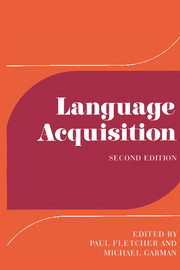Book contents
- Frontmatter
- Contents
- Contributors
- Preface
- Part I Contexts and determinants
- Part II The development of linguistic systems: phonology
- Introduction
- 7 Prespeech segmental feature development
- 8 Prosodic development
- 9 Early strategies for the perception and production of words and sounds
- 10 Phonological development: production
- 11 Speech perception and the emergent lexicon: an ethological approach
- 12 Phonological development: a crosslinguistic perspective
- Part III The development of linguistic systems: grammar
- Part IV Later language development
- Notes to chapters
- Bibliography and citation index
- General index
- Titles in the series
7 - Prespeech segmental feature development
Published online by Cambridge University Press: 05 June 2012
- Frontmatter
- Contents
- Contributors
- Preface
- Part I Contexts and determinants
- Part II The development of linguistic systems: phonology
- Introduction
- 7 Prespeech segmental feature development
- 8 Prosodic development
- 9 Early strategies for the perception and production of words and sounds
- 10 Phonological development: production
- 11 Speech perception and the emergent lexicon: an ethological approach
- 12 Phonological development: a crosslinguistic perspective
- Part III The development of linguistic systems: grammar
- Part IV Later language development
- Notes to chapters
- Bibliography and citation index
- General index
- Titles in the series
Summary
Introduction
In the first part of the twentieth century, investigators who studied infant vocal output had two quite different aims in mind. One group wished to trace the development of the adult spoken language system, usually German or English (Stern and Stern 1928; Leopold 1947); the other group was concerned with scales for measuring psychological development in infants and was, therefore, concerned with infant behaviour per se (Cattell 1940; Gesell and Amatruda 1941, and others). Both groups, however, lacked the tools for adequate description of infant vocal behaviour. Their observations are of interest, but the findings yielded little understanding of the developmental processes which might be involved.
Although it was contrary to some of the evidence already accumulated, particularly in the work of Gregoire (1939), the view was expressed that prespeech vocal behaviour was a completely random activity, subject to no developmental laws. In this activity, the infant was said to produce ‘all possible sounds’. Jakobson (1968) is most widely quoted in support of this view but others have espoused it also (Osgood 1953; Lenneberg 1962; Rees 1972). This view also implies that there is a sharp discontinuity between the period of random articulatory activity and the production of first words which is subject to developmental laws having certain universal aspects (Jakobson 1968).
In subsequent work, interest in the developmental processes that might be reflected in prespeech vocal behaviour began to be manifested.
- Type
- Chapter
- Information
- Language AcquisitionStudies in First Language Development, pp. 149 - 173Publisher: Cambridge University PressPrint publication year: 1986
- 20
- Cited by



